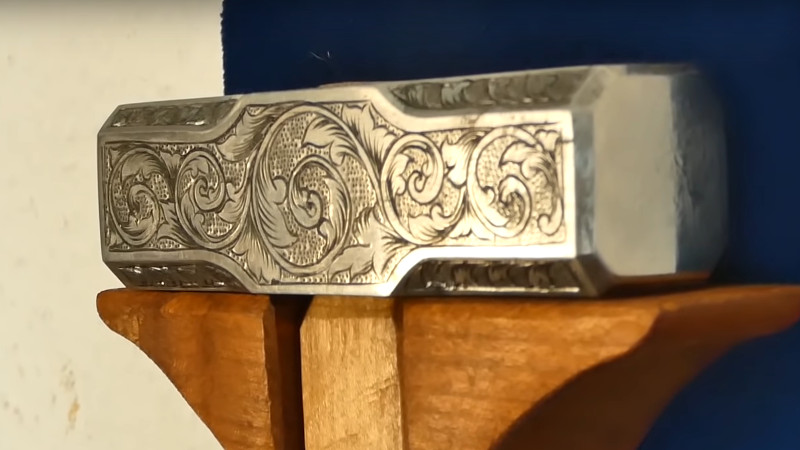Tools are a key part of any maker’s pursuit of their work. For most of us, our tools come from the local hardware store or are purchased online. Some prefer to craft their own, however, and [Uri Tuchman] is just one such person.
[Uri] starts at the absolute beginning, with a piece of unfinished rectangular stock. The workpiece is marked up, and the shape of the hammer head meticulously filed out by hand. The wooden handle is similarly prepared from raw stock with a combination of planes, chisels and files.
It may not be the fastest way to work, but careful hand craftsmanship is always impressive to watch. The build also showcases [Uri]’s talent at engraving, with the complex designs all carved out of the surface a millimeter at a time. [Uri] recommends enamel paint to highlight such works, for its rich color and the ease of removing excess paint.
Where [Uri] has built a beautiful piece of art that moonlights as a hammer, it’s possible to go in completely the opposite direction with a build. Video after the break.
[Thanks to BrightBlueJim for the tip!]
















Absolute beginning = iron ore and charcoal… some do this, so it is worth not defining a stock bar as absolute beginning
But it sounds good.
“Im Anfang war der Wasserstoff”
Carl Sagan said “to create an apple pie from scratch you must first create the universe”, so it’s not worth defining iron ore and charcoal as absolute beginning.
Nice. Almast Middle-age style craftmanship.
Balding on top?
Looks like something Thor would use.
Hammers were common weapons in Anticking and Middle-age: they were cheap counter-measure to heavy armors, deforming them and causing severe injuries.
It looks great, but I am afraid it doesn’t hammer well. The stock seems to be relatively soft, otherwise he wouldn’t be able to do file it, let alone engrave. Before mounting the handle the hammer should be hardened and tempered. But only at the ends, so the metal around the handle remains soft and doesn’t break.
https://www.youtube.com/watch?v=HTV0nX6vb_0
I was wondering about that. It seems like the beautifully engraved hammer might be best kept for nonferrous sheet metal work, rather than bashing in nails. To be honest I wish I could engrave even a tenth as well as that, but I’d save the effort for something like a machinist’s soft-face hammer with replaceable faces. Or for something I don’t have to swing about near hard bits of metal in order to use.
Perhaps it was intended for bashing heads, which probably wouldn’t do it too much harm.
The steel could be case hardened. that would make it a little more resilient.
Having hand forged more than my share of hammers and the likes there are a few things that are missing.
The hole in the hammer should be hot punched. the reason for this is steel has a kind of grain like wood and the punching parts the grain and maintains the structural strength.
The facets on the ends are for several reason,
They stop the ends of the hammer form mushrooming out
They decrease the surface area of the face and that increases the pressure when its hit on something.
Lastly when the facets are forged in its usually done at a specific temperature that compresses the grain structure. Its similar to the method used for tamping the steel in a chisel end.
Usually a hammer is hardened then a temper is drawn back so as to ensure that the steel will not crack or shatter when its hit.
Saying that I really love this :) Steel is not an easy thing to engrave.
For the next one I would love to see him use a wider graver and notch the edges then beat some soft copper wire in to it :) The process was used by by the norse and others to embellish axes etc with silver.
In addition to tool and die maker and watchmaker I am also blacksmith most of the year when our forge is open, and you are spot on on all those points.
I have actually watched a beginner with only a couple months experience of evenings one night a week forge his own hammer from 4140 bar stock. Honestly guys it’s not that hard if you have a blacksmith to teach you. You can totally make your own Hammerhead at home, using just charcoal in a home forge, with a hand blower for less than 100$. Fort Allen in Scotdale, PA is where I forge, and it’s the largest open forge in the US as far as I know. We do it that way with just coal and a drift.
The hard part is drifting the hole for the handle, you need to quench your drift after every hit and sprinkle graphite into the hole so that the drift doesn’t stick. Powerhammers help speed it up.
The hard part here is definitely the engraving, and that takes serious skill and understanding how to make a graver. A GRS engravers ball vice helps, but you can do the same cheaper with an old bowling ball with a flat ground onto it to lay your work, and rest it in a coffee can to pivot it. Having an engraving vise makes engraving much much quicker and much easier
Whow. I’m flattend – again. This is as amazing craftmanship as with the astrolab last month.
That hammers is beautiful! I would be afraid to use it as a hammer though, considering what my mini sledgehamer looks like.
More of a ceremonial than a useable hammer, since engravable steel is as soft as the original mail-order $5.99 ball peen hammer set from harbor freight. Tenpenny nails and the like would brand their faces neatly (which ain’t good)
I like it.
Funny, he doesn’t look like Sindri.
https://en.wikipedia.org/wiki/Mj%C3%B6lnir
Completely amazing!